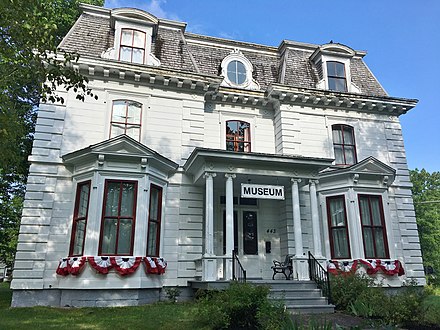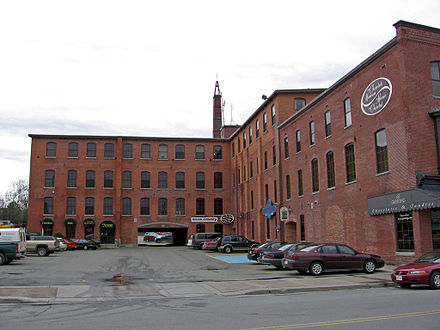St. Stephen - town in Charlotte County, New Brunswick, Canada
St. Stephen is a town of 4,400 people in southern New Brunswick.
Understand
 Tiny St. Stephen is known for two things; its close ties to Calais (Maine) directly across the river and its history as "Canada's Chocolate Town". Ganong has made candy locally since 1873; the company is now operated by the fourth generation of the family.
Tiny St. Stephen is known for two things; its close ties to Calais (Maine) directly across the river and its history as "Canada's Chocolate Town". Ganong has made candy locally since 1873; the company is now operated by the fourth generation of the family.
Residents of St. Stephen and Calais often regard their community as one place, cooperating in their fire departments and other community projects. As evidence of the longtime friendship between the towns, during the War of 1812, the British military provided St. Stephen with a large supply of gunpowder for protection against the enemy Americans in Calais, but the town elders gave the gunpowder to Calais for its Fourth of July celebrations. For much of their history, both towns' fire departments have responded in tandem to any fire call on either side of the border.
History
The Passamaquoddy Indigenous people were the first to make their home along the St. Croix River. They dispersed and hunted inland in the winter; in the summer, they gathered more closely together on the coast and islands, and primarily harvested seafood, including porpoise. In 1604, French explorer Samuel de Champlain and his men spent a winter here. The Passamaquoddy were forced off their original lands repeatedly by European settlers since that time.
St. Stephen was incorporated as a town in 1871.
Prior to World War II, St. Stephen’s local economy was heavily based in the lumber and ship building industry. At the end of the 18th century, there were at least 100 dry docks and slips along the river, shared by the cities of Calais and St. Stephen. Lumbering companies were located along both the Canadian and American sides of the river. By the early 1900s, 200 ships had been built in the St. Croix waters. However, by the end of World War II the town's main employers were Ganong Bros. Limited, Canada's oldest candy company, established 1873; and the St. Croix Cotton Mill, Canada's second largest textile mill, with 20,000 spindles, which opened its doors in June 1882 and operated its own hydro-electric generating station, the Milltown Dam. Electricity generated by the Milltown Dam is exported to the United States, connected to a transmission circuit. In 1957, the textile mill closed, and it was demolished in 1972. At one time, the St. Croix Cotton Mill employed as many as 1200 people at peak periods. Ganong remains a key employer.
Climate
The climate is temperate but greatly affected by the size of the Bay of Fundy. The bay is a cool body of water which acts as an air conditioner in the summer and diverts major snow storms in the winter. The bay never freezes. The average summer temperature is 22 °C with the average winter temperature being -3.9 °C.
Get in
St. Stephen is served by NB Route 1 and Route 170.
US Route 1 serves Calais, directly across the St. Croix River in the United States of America.
Get around
- Friendly Cab, +1 506 466-5500. 2019-05-05
See
- The Chocolate Museum, 73 Milltown Blvd, +1 506 466-7848. M-Sa 10AM-4PM. Learn about candy making with hands-on exhibits, vintage chocolate boxes, antique candy-making equipment and machines in what used to be the original Ganong factory. Chocolatiers make the candy by hand as they have for over 100 years. Adults $10, students $8.50, seniors $8:50, family $30, 4 & under free; plus tax 2019-05-05
Do
Events
- Chocolate Fest, 9 Mark St (office), +1 506 465-5616. First week in August. Every August since 1985, the town has played host to the week-long Chocolate Fest.
- International Festival. A week-long festival in early August co-hosted with the neighbouring town of Calais, Maine. There's an concerts, an international parade, and a soap box derby. 2019-05-05
Buy
- Ganong Chocolatier, 73 Milltown Blvd (at The Chocolate Museum), +1 506 465-5611. Jan-May: Tu-Sa 10AM-4PM; June: M-Sa 9AM-5PM; Jul-Aug: M-F 9AM-7PM; Sa M-Sa 9AM-5PM, Su M-Sa 10AM-5PM; Sep-Dec: M-Sa 9AM-5PM, 1st 3 Sundays in Dec: 10AM-5PM. An old-style chocolate shop (not an outlet store). 2019-05-05
- Old Ridge Antiques, 9296 Route 3, 45.213253°, -67.2768887°, +1 506-466-6011. M-Sa 10AM-5PM. 2019-05-05
Eat
- Carman's Diner, 164 King St, 45.1922983°, -67.2811507°, +1 506-466-3528. M-Sa 7AM-9PM, Su 8AM-8PM. An authentic 1950s diner that is family-owned and -operated. 2019-05-05
- Golden Chinese Restaurant, 43 Milltown Blvd, +1 506-467-9295. Tu-Su 11:30AM-9PM. Menu or buffet. Szechuan and durry dishes. 2019-05-05
- Something's Brewing Cafe, 140 Milltown Blvd, +1 506-466-2211. M-Th 7AM-6PM, F Sa 7AM-8PM, Su 8AM-6PM. Soups and sandwiches. Art by local artists. Free Wi-Fi. 2019-05-05
Drink
- Five Kings Restaurant & Picaroons Brewhouse, 5 King Street (Waterfront, in the old Canadian Pacific Railway Station), +1 506-466-2739. Su-Tu 11:30AM-9PM, W Th 11:30AM-10PM, F Sa 11:30AM-11PM. Fresh beer brewed on site, a full seasonal menu. 2019-05-05
Sleep
- Blair House Heritage Inn, 38 Prince William St, 45.19383°, -67.27066°, +1 506 INN-A-BED. Victorian heritage bed and breakfast, smoke-free inside, perennial flower and shrub gardens, garden bench and outdoor porch chairs. From $129 2019-05-05
- Scoodic Motel, 241 Route 170, Oak Bay, +1 506 466-1540. Clean, quiet, comfortable, small rooms with microwave and mini-fridge. Pets allowed. Continental breakfast included. Playground. From $89 2019-05-05
- Winsome Inn, 198 King St, +1 506-466-2130. Canada Select 3½ stars. Rooms with microwave and mini-fridge. Pets allowed. Continental breakfast included. Playground and barbecue. $100-150 2019-05-05
Connect
- St. Croix Public Library, 11 King St, +1 506-466-7529. Tu 1PM-8PM, W-Sa 10AM-5PM. The public library has internet-connected computers available for public use. 2019-05-18
Go next
St. Stephen
town.ststephen.nb.caNew Brunswick
Primary administrative division
